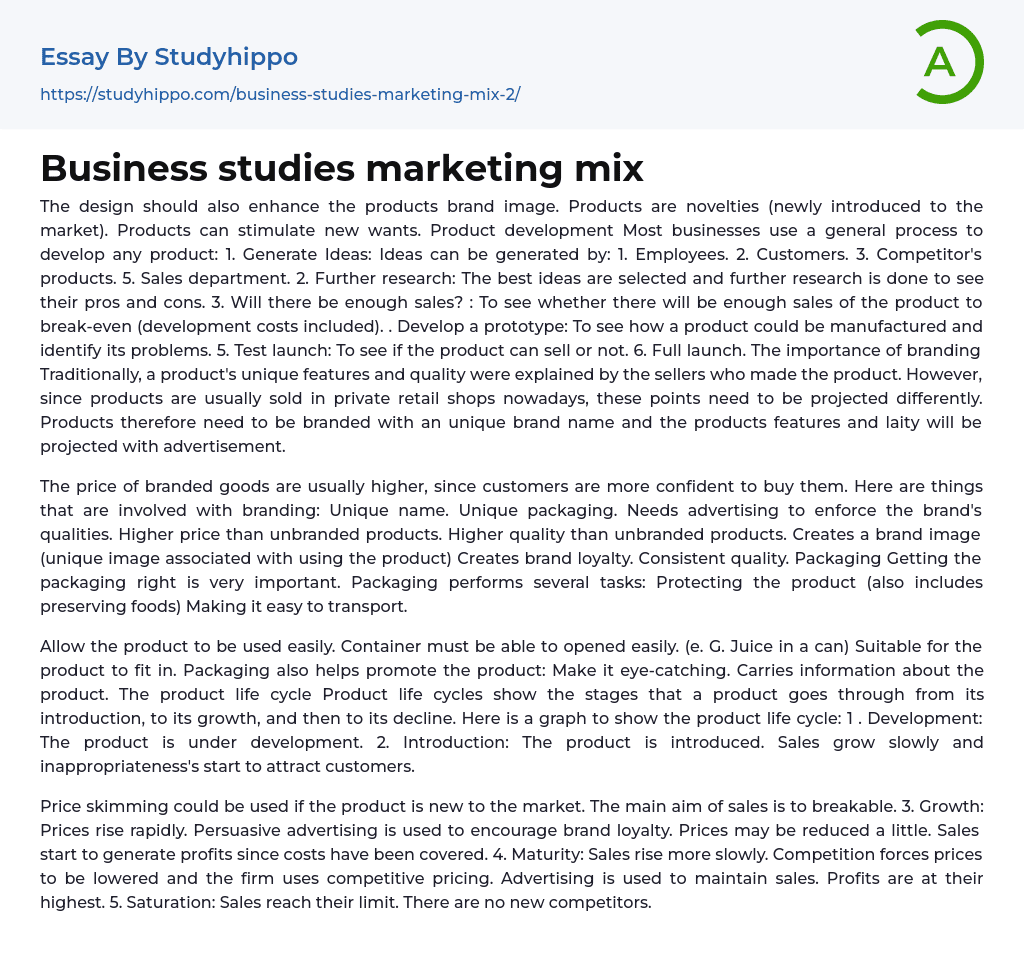The design of the product should enhance the brand image. The products are novelties and can stimulate new wants. The product development process involves generating ideas from employees, customers, competitor's products, and the sales department. Further research is conducted to evaluate the pros and cons of the selected ideas. Sales potential is assessed to determine if there will be enough sales to cover development costs. A prototype is developed to identify any issues with manufacturing. There is a test launch to determine the product's marketability, followed by a full launch. Branding plays a significant role in projecting a product's unique features and quality, especially since products are predominantly sold in private retail shops. Branded goods tend to have a higher price as customers have more confidence in them. Branding involves having a unique name, packaging, and advertising to showcase the brand
...'s qualities. Branded products also typically have a higher quality than unbranded ones.The text discusses various aspects of packaging and its importance in creating a brand image, loyalty, and promoting the product. It emphasizes the need for the packaging to protect, transport, and easily open the product. Additionally, packaging should be suitable for the product and visually appealing while providing information. The text also mentions the product life cycle and its stages of development, introduction, growth, maturity, and saturation. It highlights the use of price skimming and persuasive advertising during the growth stage to generate profits and maintain sales. Ultimately, it states that sales reach their limit in the saturation stage when there are no new competitors.
Sales and advertising stabilize, but profits decrease due to lowering prices to remain competitive. The decline stage occur
when a product goes out of fashion, leading to a decline in sales and profits. Eventually, advertising stops and it becomes unprofitable to produce the product. The duration of each stage varies for different products. Businesses need to determine the stage their products are in to implement an appropriate marketing strategy. To extend the product life cycle, businesses may utilize strategies such as introducing new variations of the product, expanding into new markets, making small changes to design and packaging, selling through different retail outlets, updating the product, and launching new advertising campaigns. These extension strategies aim to prolong the maturity stage of a product. However, it is important to note that businesses often manufacture multiple products.
- Sales Promotion essays
- Advertising campaign essays
- Wal-Mart essays
- Discover essays
- Advertisement essays
- Advertising essays
- Anheuser-busch essays
- Audience Theory essays
- Brand essays
- Brands essays
- Competitor Analysis essays
- Consumer essays
- Detergent essays
- Marketing Management essays
- Marketing Mix essays
- Marketing Plan essays
- Marketing Research essays
- Marketing Strategy essays
- New Product Development essays
- Point Of Sale essays
- Price essays
- Procurement essays
- Product essays
- Product Differentiation essays
- Product Placement essays
- Promotion essays
- Promotion And Marketing Communications essays
- Research Design essays
- Retailing essays
- Trademark essays
- Accounting essays
- Andrew Carnegie essays
- Automation essays
- Business Cycle essays
- Business Intelligence essays
- Business Model essays
- Business Operations essays
- Business Software essays
- Cooperation essays
- Cooperative essays
- Corporate Social Responsibility essays
- Corporation essays
- Customer Relationship Management essays
- Family Business essays
- Franchising essays
- Harvard Business School essays
- Harvard university essays
- Human Resource Management essays
- Infrastructure essays
- Inventory essays




